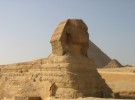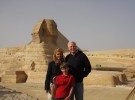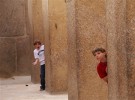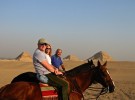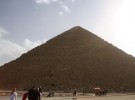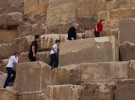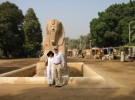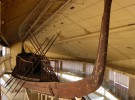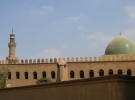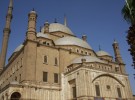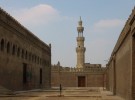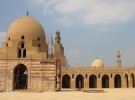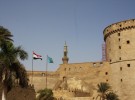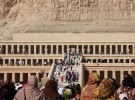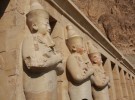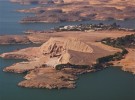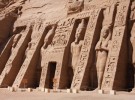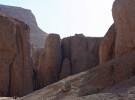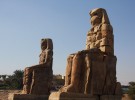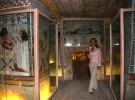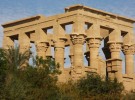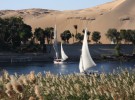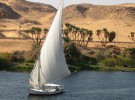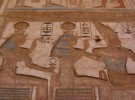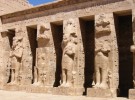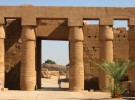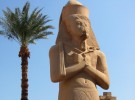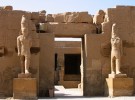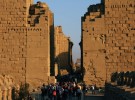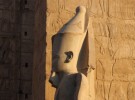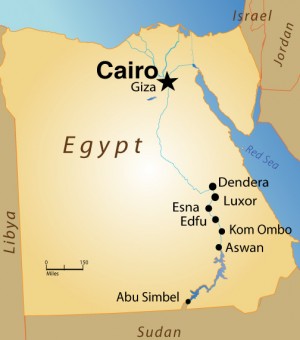Destinations > Africa > Egypt > Egypt
Destination:
Egypt
- Overview
- Basics
- Getting Ready
- Best Hotels
- What to Buy
- Egypt Itinerary
- Egypt & Jordan Itinerary
- MLS Signature Trip: Treasures of the Nile
- Explore by Area
- Trip Extensions
- Travel Tips
- Contacts
Getting Ready
topHistory
The first Nile settlements date back thousands of years before the pharaohs, when nomadic tribes left the increasingly dry Savannah for the fertile floodplains of the Nile valley. As the settlements grew, the need to organize them led to the invention of hieroglyphics, the world's earliest form of writing. Eventually the area split into two kingdoms, Upper Egypt and Lower Egypt. These kingdoms were united around 3100 BC by Menes, the first pharaoh of Egypt, creating the world's first nation state.
Old Kingdom
3100 - 2180 BCThis period is called “Age of the Pyramids” for the large number of royal burial places built at the time, including the Step Pyramid at Saqqara and the Great Pyramid of Giza. Power was centered at Memphis, the first capital of united Egypt.
1st Intermediate, Middle Kingdom & 2nd Intermediate Period
2180 - 1550 BCAfter decades of famine and strife, the Old Kingdom collapsed. Egypt fragmented into smaller kingdoms, resulting in anarchy and civil wars. A powerful Theban warlord, Menuhotep II, reunited the country under the 11th Dynasty, and the stable Middle Kingdom began. This time is known as the “classic” period of art and literature. Egypt's borders were expanded through military conquests, and royal authority was centralized, forming a bureaucracy. Settlers from Palestine, called Hyksos, infiltrated the government and assumed control in 1650 BC, marking the beginning of the Second Intermediate Period. Egypt was once again divided, with Hyksos ruling the north, and native Egyptians ruling the south.
New Kingdom
1550 - 1070 BCWith the reunification of Egypt, a “Golden Age” began, marked by power and prosperity. Some of the best-known pharaohs ruled during this time, including Hatshepsut (the famous female pharaoh) and Tutankhamun (King Tut). Another pharaoh who made a lasting impact was Ramses II, of the 19th Dynasty; temples and monuments from his reign are among the largest and most glorious in Egypt. Ramses III was known for successfully defending Egypt from foreign invaders, but his successors were not so fortunate, and the New Kingdom collapsed in 1070 BC.
3rd Intermediate, Late, and Ptolemaic Periods
1070 - 30 BCThe Third Intermediate Period covered 400 years of fragmentation and chaos. The Late Period began with the Assyrian invasion of Egypt in 669 BC. Psamtek, the Assyrian's vassal king, brought stability during his reign from the new capital, Sais, but peace lasted less than 100 years. Persians invaded in 525 – their domination lasted until Alexander the Great “liberated” Egypt in 332 BC and founded his new capital, Alexandria. After Alexander's death, his trusted companion, Ptolemy, assumed power. His successors ruled for nearly 300 years, a time known as the Ptolemic period. Cleopatra VII, the last of the Ptolemies, rose to the throne in 51 BC. After her suicide, Egypt became a Roman province.
Roman and Arab Rule
Egypt was conquered by Octavian of Rome in 30 BC, and was ruled by Romans (and later Byzantines) until the 7th Century. Christianity spread during this time, but the Coptic faith that developed in Egypt was not well accepted by Roman authorities. In 646 AD, Muslim Arabs defeated the Byzantines, and Egypt became a province of the vast Islamic empire. Fatimids from Tunisia seized control in 969 and founded Cairo, but were overthrown by a warrior general, Salah ad-Din, in 1171. His successors, a magnificent warrior caste called the Mamluks, ruled until 1517, when Ottoman Turks invaded Cairo.
Napoleon and Mohammed Ali
Egypt's influence declined under Ottoman Rule. In 1798, France invaded under the command of Napoleon Bonaparte. The French made an exhaustive study of Egypt, causing interest in ancient Egyptian history, art and language to rise significantly. The French retreat resulted in a power struggle, which was won in 1805 by an Ottoman commander named Mohammed Ali. Regarded as the "founder of modern Egypt," he and his successors began transforming Egypt into an industrialized nation. However, projects like the Suez Canal were largely funded by European banks, and the country became increasingly indebted to Britain.
Occupation and Revolution
The British occupied Egypt in 1882, and took even firmer control during World War I. Nationalist demands for autonomy were ignored, leading to a rebellion in 1919. Britain recognized Egypt as an independent state in 1922, and a representative government under King Fuad I was established. After the Palestine War of 1948, the king was deposed and in 1953, Egypt was declared a republic. Gamal Abdel Nasser was elected president soon after and his nationalistic policies made him a hero. The era ended abruptly in 1967, however, with Egypt's defeat by Israel in the Six Day War.
Sadat and Mubarak
Nasser's successor, Anwar Sadat, was known for both belligerence and peace – launching a surprise attack on Israeli lines in 1973, and then paving the way for peace talks in 1979. Sadat was assassinated in 1981 and succeeded by his vice-president, Hosni Mubarak, who served as president for 30 years. In early 2011, thousands of citizens rose in protest against his autocratic regime, which had offered political stability but stifled the country economically. In February 2011, Mubarak resigned, turning the government over to the military until a new government is formed. The long-term outcome of this transition remains to be seen.
topBooks for Adults
Traveling Through Egypt, From 450 B.C. to the Twentieth Century
Sahar Abdel-Hakim and Deborah Manley • HistoryFor centuries, Egypt has inspired writers from Herodotus to Twain to share their observations and experiences. This terrific anthology features travelogues, histories and memoirs of every part of Egypt, organized geographically. Buy now
The Search for Ancient Egypt
Jean Vercoutter • ArchaeologyA pocket-size encyclopedia of archaeology and history, packed with illustrations, maps and archival photographs. Part of the “Discoveries” series, it documents the rediscovery of Egypt by modern Europeans. Buy now
Think Like an Egyptian, 100 Hieroglyphs
Barry Kemp • Language & PhrasebookIf you’d like to decipher the hieroglyphics you find along your journey, this short book will help you understand the ancient Egyptian language. Buy now
The Memoirs of Cleopatra
Margaret George • LiteratureThoroughly researched and detailed, this novel tells the fascinating life story of one of history’s most famous rulers. The kingdom of Cleopatra comes to life in this tale of ambition, passion and betrayal. Buy now
The Cairo Trilogy: Palace Walk, Palace of Desire, Sugar Street
Naguib Mahfouz • LiteratureThe Nobel Prize-winner's epic trilogy of colonial Egypt follows three generations of a Cairo family through the political and domestic turmoil of the early 20th century. Buy now
Death on the Nile
Agatha Christie • MysteryChristie wrote Egypt's most famous murder mystery on the terrace of the Old Cataract Hotel in Aswan. Featuring the endearing Hercule Poirot, the novel is set on a Nile River boat that seems idyllic for a honeymoon – until the newly wed wife is found murdered. Buy now
Petra
Maria Giulia Amadasi Guzzo and Eugenia Equini Schneider • ArchaeologyComprehensive and lavishly illustrated, this book delves into the fascinating history of the Nabatean civilization and the mysterious city they left behind. Buy now
topBooks for the Kids
The Awesome Egyptians
Terry Deary • Horrible Histories Series • Kids Any AgeThese books make history entertaining and memorable for kids by leaving in the yucky parts. This volume discusses the gory details of how mummies were made and the basics of Egyptian arithmetic. Buy now Click to buy the Awesome Egyptians Activity Book
Cleopatra VII, Daughter of the Nile
Kristiana Gregory • Royal Diaries Series • Young AdultsTold through journal entries, this book shows how twelve-year-old Cleopatra may have viewed her tumultuous life, as her father goes into exile and her sister tries to seize the throne.
Buy now
Hatshepsut, The Princess Who Became King
Ellen Galford • History • Middle Readers (Age 9-12)A lively, illustrated biography in the National Geographic World History series, this book tells of the incredible rise and long reign of Egypt’s most successful female pharaoh. Buy now
Tales of Ancient Egypt
Roger Lancelyn Green • Young AdultsDivided into “Gods,” “Magic” and “Adventures,” these tales include stories, myths, and legends from Egypt and its neighboring lands. Buy now
Red Sea Sharks, The Adventures of Tintin
Herge • Literature • Middle Readers (Age 9-12)For fans of the Belgian comic book series, here are the adventures of intrepid reporter Tintin as he confronts the gangster and slave-trader Marquis di Gorgonzola. Buy now
The Pocket Timeline of Ancient Egypt
Helen Strudwick • History • Young AdultsA beautifully illustrated, portable guide to the history and achievements of this ancient civilization, from prehistoric times to the reign of Cleopatra. Buy now
Ancient Egypt Workbook
Dorling Kindersley • Cultural Portrait • Young Readers (Age 4-8)Gets young readers interested in the history, geography and culture of Ancient Egypt through fun activities like stickers and quizzes. Buy now
Egyptology: Search for the Tomb of Osiris
Dugald Steer • Archaelogy • Young Readers (Age 4-8)This clever scrapbook claims to be the lost journal of 1924 amateur Egyptologist Emily Sands. Filled with photographs, letters and other memorabilia, it’s an excellent introduction to archaeology and Egyptian art, architecture and hieroglyphics. Buy now
The Egyptology Handbook, A Course in the Wonders of Egypt
Dugald Steer • Archaelogy • Young Readers (Age 4-8)This companion piece to Egyptology brims with flaps and foldouts, stickers, illustrations, and intriguing assignments while offering good information on life and culture in ancient Egypt.
Buy now
Ancient Egypt Scratch and Sketch
Suzanne Beilenson • Martha Day Zschock • Young Readers (Age 4-8)In this spiral-bound art and activity book, readers use a wooden stylus to trace artwork that teaches them about life on the Nile. Buy now
Ancient Egypt Design Coloring Book
Ed Sibbet • Art & Architecture • Young Readers (Age 4-8)Features 39 authentic pictures of wall paintings and sculptures from ancient Egyptian tombs and monuments. Buy now
topDVDs
Cairo Time (2010)
Directed by Ruba Nadda, starring Patricia Clarkson, Alexander SiddigA romantic drama and beautiful film set in Cairo about a married magazine editor who falls for one of her husband's old acquaintances while vacationing in Cairo. Buy now
Jumper (2008)
Directed by Doug Liman, starring Hayden Christensen, Jamie Bell, Rachel Bilson and Samuel L. JacksonFollowing a near-death experience, a young man discovers he has the ability to teleport himself anywhere. After years of adventure, visiting the most exotic locales on earth, he finds himself in the middle of a centuries-old war between "Jumpers" and those who have sworn to kill them.
Buy now
Into the Great Pyramid (2002)
National Geographic DocumentaryNoted Egyptologist Zahi Al-Hawass sheds light on some of the most enduring mysteries of the pyramids. Witness the opening of Egypt’s oldest sarcophagus, follow a robot into secret shaft of the Great Pyramid, and discover new clues about how the pyramids were built. Buy now
The Mummy Returns (2001)
Directed by Stephen Sommers, starring Brendan Fraser and Rachel WeiszThe mummified body of Imhotep is shipped to the British Museum, where he is again resurrected, with a new goal – to raise the ancient Scorpion King, take over his mighty army, and use it to destroy mankind. Rick and Evelyn must save the world, and their son, from unspeakable terror.
Buy now
The Mummy (1999)
Directed by Stephen Sommers, starring Brendan Fraser and Rachel WeiszSet in 1923, this adventure film is the story of Evelyn, an aspiring Egyptologist who enlists the help of Rick, an American Legionnaire, on an expedition to an ancient city. They accidentally awaken the mummy of evil High Priest Imhotep – and must stop him before he wreaks his final vengeance. Buy now
Egypt - Quest for Eternity (1982)
National Geographic DocumentaryJoin Egyptologists as they unravel the riddles of Egypt’s mysterious past. This dazzling film guides viewers through treasures like the Sphinx and the temples at Luxor and Karnak, exploring several different royal burial chambers and tombs. Buy now
Raiders of the Lost Ark (1981)
Directed by Steven Spielberg, starring Harrison Ford and Karen AllenIn this classic adventure set in 1936, archaeologist and adventurer Indiana Jones is hired by the U.S. to find the Ark of the Covenant – which has enormous mystical powers – before the Nazis can get their hands on it. Indy’s journeys take him from South America to Nepal and finally to Egypt, where the powers of the Ark are about to be unleashed. Buy now
Lawrence of Arabia (1962)
Directed by David Lean, starring Peter O’Toole, Omar Sharif, Alec Guinness and Anthony QuinnThis sweeping epic is based on the life of T. S. Lawrence, an enigmatic British officer during WWI who enlists the help of Arabian tribes in the fight against the Turks. Lawrence struggles with divided loyalties to the Arabs and his native Britain, and with his reaction to the violence of war. Shot largely in Jordan, at Petra and Wadi Rum among other locations, the film is considered a cinematic masterpiece. It won Academy Awards for Best Picture, Best Director and Best Cinematography. Buy now
topWebsite
topPacking List
Clothing
-Women's clothes should be lightweight, loose-fitting, opaque and cover your chest, shoulders, upper arms and your legs below the knees. Natural fibers are the most comfortable. Pack a scarf that can double as lightweight cover-up and a headscarf.
-Men can wear short-sleeved shirts in the summer, but even then may prefer to wear long sleeve shirts and long pants.
-Bring 2 pairs of comfortable walking shoes, preferably closed-toe.
Sun protection
-Bring wide-brimmed hat, sunscreen, water bottles, T-shirts to swim in and a daypack or bag.
Cameras & Binoculars
-Reliable digital camera for each child.
-Digital SLR with 18 - 70mm zoom, 70 - 200 or 300mm zoom, and a 100mm macro lens. Lightweight monopod or tripod.
-Pair of good binoculars per adult member of the group. Manual focus. 7x -10x.
-Binoculars for each child.
Misc. items
-Flashlight is recommended in case of power outage.
-Tissues for public restrooms are also advisable.
Copyright 2013 MyLittleSwans, LLC. All rights reserved. My Little Swans, the logo and Share a world of experience are registered Trademarks of MyLittleSwans, LLC. Use of this site constitutes acceptance of our Terms of Use and Privacy Policy.


